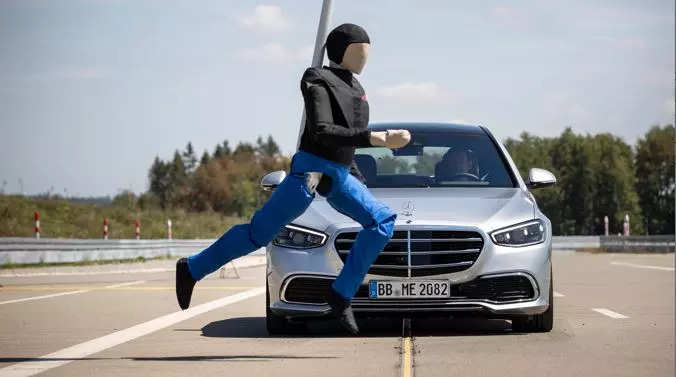
With more than 40 active assistance systems currently available, Mercedes-Benz is making a decisive contribution to increasing the safety of all road users. In particular, Active Brake Assist with pedestrian detection has been helping reduce accidents involving pedestrians and cyclists for many years. This applies to typical driving speeds both in and out of town.
The system can give visual and acoustic warnings of an impending collision in front of the vehicle, either from intersecting or oncoming vehicles. If the driver brakes too lightly, the system can provide assistance and increase the braking force to suit the situation. If the driver fails to react at all, Active Brake Assist initiates emergency braking. In the current generation of vehicles, Active Brake Assist uses camera and/or radar-based sensor technology to detect pedestrians and cyclists in front of the vehicle in the direction of travel. If an imminent risk of collision with these so-called vulnerable road users is detected, the required braking force is calculated in order to avoid a possible collision or to minimize its severity.
Now, Mercedes-Benz has achieved another active safety milestone: Since 2012, more than 10 million of all Mercedes-Benz passenger cars sold worldwide have been equipped with the pedestrian emergency braking system. Pedestrians are considered unprotected road users as they are not equipped with airbags, seat belts or protective clothing. Their particular risk is also reflected in accident statistics: according to an analysis by the European Commission, pedestrians made up almost one-fifth of all road fatalities in the European Union in 2020.
In the USA, their share of the total number of traffic fatalities in 2021 was 17% according to the National Highway Traffic Safety Administration. Meanwhile, a 2022 study by the American Insurance Institute for Highway Safety concluded that vehicles equipped with a pedestrian emergency braking system have a 27% lower rate of accidents involving pedestrians than vehicles without such technology.
Warning and support in the event of acute accident risk Mercedes-Benz introduced the first Brake Assist System (BAS) back in 1996. In 2005, radar technology was used to enhance the brake assist system by making it anticipatory. Just one year later, experts combined the further developed DISTRONIC PLUS distance control system and BAS PLUS Brake Assist to create PRE-SAFE Brake with autonomous partial braking. The important pedestrian detection feature was added in 2013, and first introduced in the E-Class (W212). In 2016, the pedestrian emergency braking system was then installed as standard equipment for the first time as part of the launch of the new E-Class (W213). Since 2021, Active Brake Assist has been standard equipment on all new Mercedes-Benz car models. This means high internal safety demands exceeded legal requirements: so-called city emergency brake assist systems for low-speed driving have only been mandatory for all types of newly approved passenger cars in the EU since July 2022. From 2024, these will be mandatory for every newly registered car.
Future assistance systems will be even more powerful thanks to increasingly advanced sensors and help from artificial intelligence. It is already apparent today that active assistance systems make an important contribution to protecting pedestrians and cyclists in particular – so-called vulnerable road users.
The real-life safety philosophy: Real-Life Safety” is the safety philosophy of the Mercedes-Benz Group. The company has been conducting systematic accident research for more than 50 years: its aim is to build vehicles that are not only convincing in defined crash-test scenarios, but also in real-life road accidents. In addition to protecting vehicle occupants, the focus is also on the safety of all road users outside the vehicle. The goal is clear: Vision Zero. This means that there should be no more accidents involving Mercedes-Benz vehicles by 2050.









